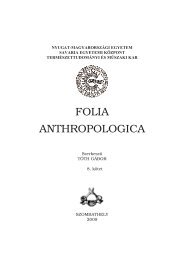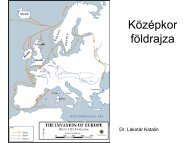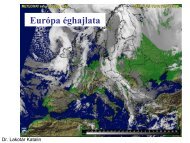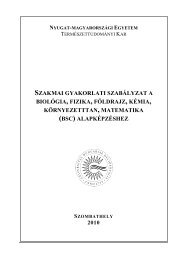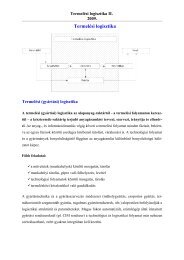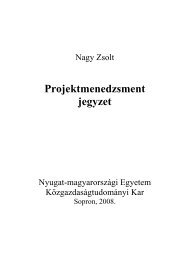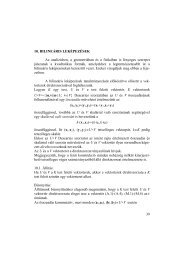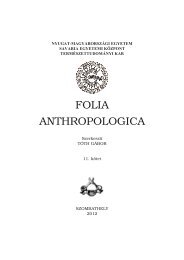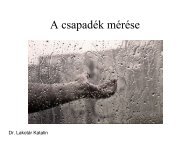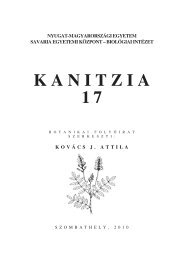Create successful ePaper yourself
Turn your PDF publications into a flip-book with our unique Google optimized e-Paper software.
Folia Anthropologica 4; 5−19. (2006)<br />
III. BÉLA KIRÁLY ÉS CHATILLON ANNA<br />
ARCREKONSTRUKCIÓJA<br />
Árpás Károly<br />
Képzőművész, arcrekonstruktőr, Bakonyoszlop, Kossuth u. 72.<br />
Árpás Károly 1977-es kézirata alapján sajtó alá rendezte és az előszót írta:<br />
Kustár Ágnes PhD. (Magyar Természettudományi Múzeum Embertani Tár, Budapest)<br />
Abstract: The facial reconstruction of the Hungarian king, Béla the 3 rd and his wife Anne Chatillon.<br />
(Edited by Ágnes Kustár on the basis of the manuscript of Károly Árpás /ÁRPÁS 1977/). The Hungarian<br />
king, Béla the 3 rd (was born between 1148-1152) ruled in Hungary for 24 years, and he died in<br />
1196, at the age of 44-48. The only authentic and identified Hungarian king’s bury excavated till now<br />
is the tomb of a king which came to light at the destroyed cathedral of Fehérvár. Károly ÁRPÁS,<br />
sculptor, worked out his anatomic method of facial recon-struction in 1968-69. He has good experience<br />
in anatomy and portrayal thanks to his artistic qualification, furthermore, he worked as a<br />
graphic artist in the field of archaeology for more than twenty years. He was charged with carrying out<br />
the facial reconstruction of the royal couple by the Hungarian National Museum in 1972.<br />
The basis of the reconstruction was the anatomy of the face that is why he terms it as the anatomic<br />
method. During the reconstruction work the muscles, the fatty tissues and the skin are built up from<br />
coloured plasticine, according to the muscle markings on the surface of the skull. The thickness and<br />
the direction of the muscles depend on the grade of expressedness of muscle insertions. First he<br />
reconstructs only the one half of the face. During this process the other half of the skull stays bonyclear,<br />
to enable permanent control between the skull and the reconstructed half-face. In the first phase<br />
he sets the head into Frankfurt horizontal plane. In the second phase he shapes the mass of the muscles<br />
of the neck and forms the deep muscles of the nape of the neck. Then he develops the mass of the nose<br />
and the eyes. In the third and the forth stages he moulds the glands and the subcutaneous fatty tissue,<br />
which partially invade into the deep layers of the face. In the fifth phase as he fashions the skin, the<br />
half-face is essentially finished. Then, in the sixth (last) phase he puts the other half of the face into<br />
shape, according to the thicknesses of the soft tissues measured in different points of the finished<br />
facehalf, taking into account the asymmetries of the face. The Sculpture as an applied technique plays<br />
a very important role throughout the whole project from shaping of the first muscle to completing the<br />
whole face.<br />
He endeavours in his work to reconstruct the clear and simple forms of the face, which suit the<br />
scientific requirements, and the forms anatomically can be proved. He avoids any disturbing surface<br />
effects and face impressions, which might mislead the observer. If the reconstructor works following<br />
exactly the principles of the anatomic method, the late person’s sex, age and physical appearance will<br />
turn up.<br />
Előszó<br />
Régi adósságot törlesztünk e dokumentáció megjelenésével. ÁRPÁS Károly elsőként készített<br />
Magyarországon hiteles, azaz antropológiailag is helytálló arcrekonstrukciót. Eljárását maga dolgozta<br />
ki, amely az anatómia törvényszerűségeire, illetve a koponya egyedi jellegzetességeinek megragadására<br />
épül (SJØVOLD 1981). ÁRPÁS Károly az arc újraszerkesztésének anatómiai módszerét 1968-69-<br />
5




